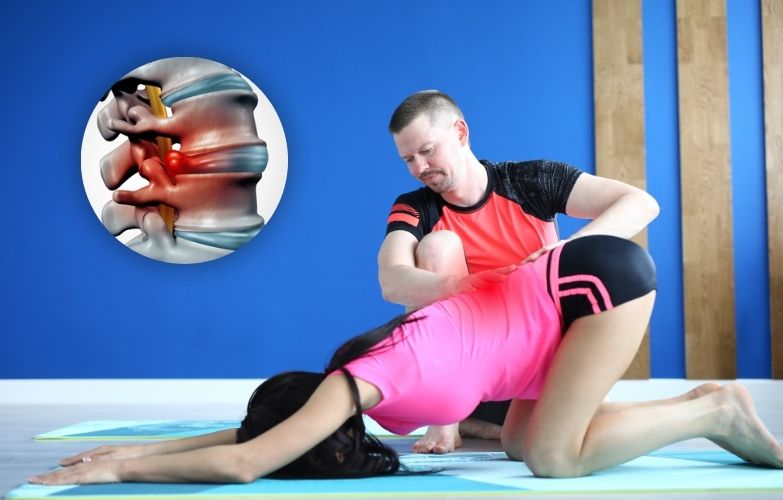A herniated disc, often referred to as a slipped or ruptured disc, occurs when the soft inner gel of a spinal disc protrudes through its outer layer. This condition can cause significant pain, discomfort, and even numbness or weakness in the limbs. While it may seem counterintuitive, movement and specific exercises can be crucial in managing the symptoms of a herniated disc. Here are seven exercises that can help alleviate pain, strengthen your core, and support your recovery.
1. Pelvic Tilt
The pelvic tilt is a gentle exercise that can help relieve lower back pain by strengthening the abdominal muscles, which play a crucial role in supporting the spine.
How to Perform:
- Lie on your back with your knees bent and feet flat on the floor, about hip-width apart.
- Place your hands on your lower abdomen.
- Slowly tilt your pelvis upward, flattening your lower back against the floor.
- Hold this position for 5 seconds, then relax.
- Repeat this movement 10 to 15 times.
Benefits: This exercise helps improve spinal alignment and reduces pressure on the herniated disc by stabilizing the lumbar spine.
2. Prone Press-Ups
Prone press-ups are excellent for extending the spine, which can help push the herniated disc material back toward its normal position, relieving nerve pressure.
How to Perform:
- Lie face down on the floor with your legs extended and arms bent, palms placed flat on the floor beneath your shoulders.
- Slowly press your upper body upward, keeping your hips and pelvis on the floor.
- Extend your arms as far as comfortable, lifting your chest off the ground.
- Hold this position for 5 to 10 seconds, then lower yourself back down.
- Repeat 10 times.
Benefits: This exercise helps relieve pain and tension in the lower back by decompressing the spine, which can alleviate nerve irritation caused by a herniated disc.
3. Cat-Cow Stretch
The cat-cow stretch is a yoga-inspired movement that promotes flexibility in the spine and can help reduce pain associated with a herniated disc.
How to Perform:
- Begin on all fours, with your hands directly under your shoulders and knees under your hips.
- Inhale as you arch your back (cow pose), lifting your head and tailbone toward the ceiling.
- Exhale as you round your back (cat pose), tucking your chin to your chest and drawing your navel toward your spine.
- Continue to alternate between these two positions for 1 to 2 minutes.
Benefits: This stretch increases spinal mobility, helps in relieving muscle tension, and improves circulation around the affected disc area.
4. Standing Hamstring Stretch
Tight hamstrings can exacerbate lower back pain, especially in those with a herniated disc. The standing hamstring stretch helps elongate the muscles in the back of the legs, reducing strain on the lower back.
How to Perform:
- Stand upright with your feet together.
- Step one foot forward and flex it at the ankle, so only the heel touches the ground.
- Bend the opposite knee slightly and hinge at the hips, lowering your torso toward the extended leg.
- Hold this stretch for 20 to 30 seconds, then switch legs.
- Repeat 2 to 3 times per leg.
Benefits: This stretch decreases tension in the hamstrings, which can reduce the pull on the lower back and ease pressure on the herniated disc.
5. Child’s Pose
Child’s pose is a gentle yoga pose that provides a deep stretch for the back muscles, helping to relieve pain and improve flexibility.
How to Perform:
- Beggin on your hands and knees.
- Sit back onto your heels while stretching your arms forward, lowering your forehead to the floor.
- Hold this position for 30 seconds to 1 minute, breathing deeply.
- Slowly return to the starting position.
Benefits: This pose helps elongate the spine, reduce muscle tension, and provide a soothing stretch to the lower back, which can be beneficial for herniated disc relief.
6. Bird-Dog Exercise
The bird-dog exercise is a great way to strengthen the core muscles, including the lower back, without putting too much strain on the spine.
How to Perform:
- Start on your hands and knees, with your hands under your shoulders and knees under your hips.
- Extend your right arm forward and your left leg backward, keeping your back straight and your core engaged.
- Hold this position for 5 seconds, then return to the starting position.
- Repeat on the opposite side.
- Perform 10 repetitions on each side.
Benefits: This exercise helps improve balance, stability, and coordination, which are all crucial for supporting the spine and reducing the risk of further injury.
7. Knee-to-Chest Stretch
The knee-to-chest stretch is a simple exercise that can help relieve lower back pain by stretching the lower back and the gluteal muscles.
How to Perform:
- Lie on your back with your knees bent and feet flat on the floor.
- Bring one knee up toward your chest, grasping it with both hands.
- Hold this position for 20 to 30 seconds, then switch legs.
- Repeat 2 to 3 times per leg.
Benefits: This stretch helps relieve tension in the lower back and glutes, which can reduce pain and pressure on the herniated disc.These exercises can be highly effective in managing the symptoms of a herniated disc, but it’s important to perform them correctly and consistently. Always consult with a healthcare professional before starting any new exercise regimen, especially if you have a herniated disc. They can provide personalized guidance and ensure that these exercises are safe and beneficial for your specific condition. Incorporating these exercises into your daily routine can help strengthen the muscles supporting your spine, alleviate pain, and improve your overall quality of life. Sanjeevani Physiotherapy Clinic in Borivali West, led by top physiotherapist Dr. K. K. Mishra, offers expert treatment for back pain, neck pain, joint pain, paralysis, stroke, sports injuries, and more. Book your appointment today for personalized care and effective recovery.
